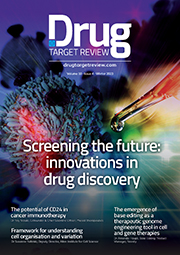Whitepaper: Development and Validation of Bio-Plex Pro™ Human Chemokine Assays
Posted: 27 September 2016 | Bio-Rad Laboratories | 2 comments
A new Bio-Plex Pro chemokine panel was validated for quantifying 40 human chemokines in one sample offering a significant advantage to researchers…
A new Bio-Plex Pro chemokine panel was validated for quantifying 40 human chemokines in one sample offering a significant advantage to researchers collecting combinatorial chemokine information with a limited sample volume.
The chemokine system belongs to a large family of inflammatory cytokines and receptors.
Approximately 50 chemokines and 20 receptors have been identified and shown to play a critical role in tumor growth, inflammatory response, infection, autoimmune disorders, neoplasm, vascular diseases, and transplant rejection (Locati et al. 2005, Slettenaar and Wilson 2006). These low molecular weight (8–10 kD) proteins can be grouped into four chemokine subfamilies (C, CC, CXC, and CX3C) according to the number of cysteine molecules and the spacing of cysteine residues (Figure 1). The C chemokines, called lymphotactins, are found in high levels in the spleen, thymus, intestine, and peripheral blood leukocytes. The CC chemokines have the first two cysteines in adjacent positions. They appear to attract monocytes, basophils, eosinophils, and lymphocytes, including NK cells. The CXC (where X denotes any amino acid) chemokines have the first two of four total cysteines separated by an amino acid. Most of them are chemo-attractants for neutrophils. The CX3C chemokines include a single molecule with three amino acids between the first two cysteine residues. The only CX3C chemokine discovered to date is fractalkine. It is both secreted and tethered to the surface of the cell that expresses it, thereby serving as both a chemo-attractant and an adhesion molecule.
This whitepaper is restricted - login or subscribe free to access


Why subscribe? Join our growing community of thousands of industry professionals and gain access to:
- quarterly issues in print and/or digital format
- case studies, whitepapers, webinars and industry-leading content
- breaking news and features
- our extensive online archive of thousands of articles and years of past issues
- ...And it's all free!
Click here to Subscribe today Login here
Related content from this organisation
- Bio-Rad introduces mixed-mode resin for biomolecule purification
- New insights into the role of viral capsids in gene therapy safety
- The essential role of recombinant phage display antibody libraries
- Optimised antibody panels for CTC and rare cell enumeration
- Developing next generation non-replicative HSV-1 vectors for sustainable and more precise gene therapies
Related topics
Amino Acids, Assays
Related organisations
Bio-Rad Laboratories










I would like to read this paper
Dear Ravindra,
Thank you for your message.
You can view this whitepaper by either login in or registering to view this whitepaper.
Kind regards
Charlotte Batchelor